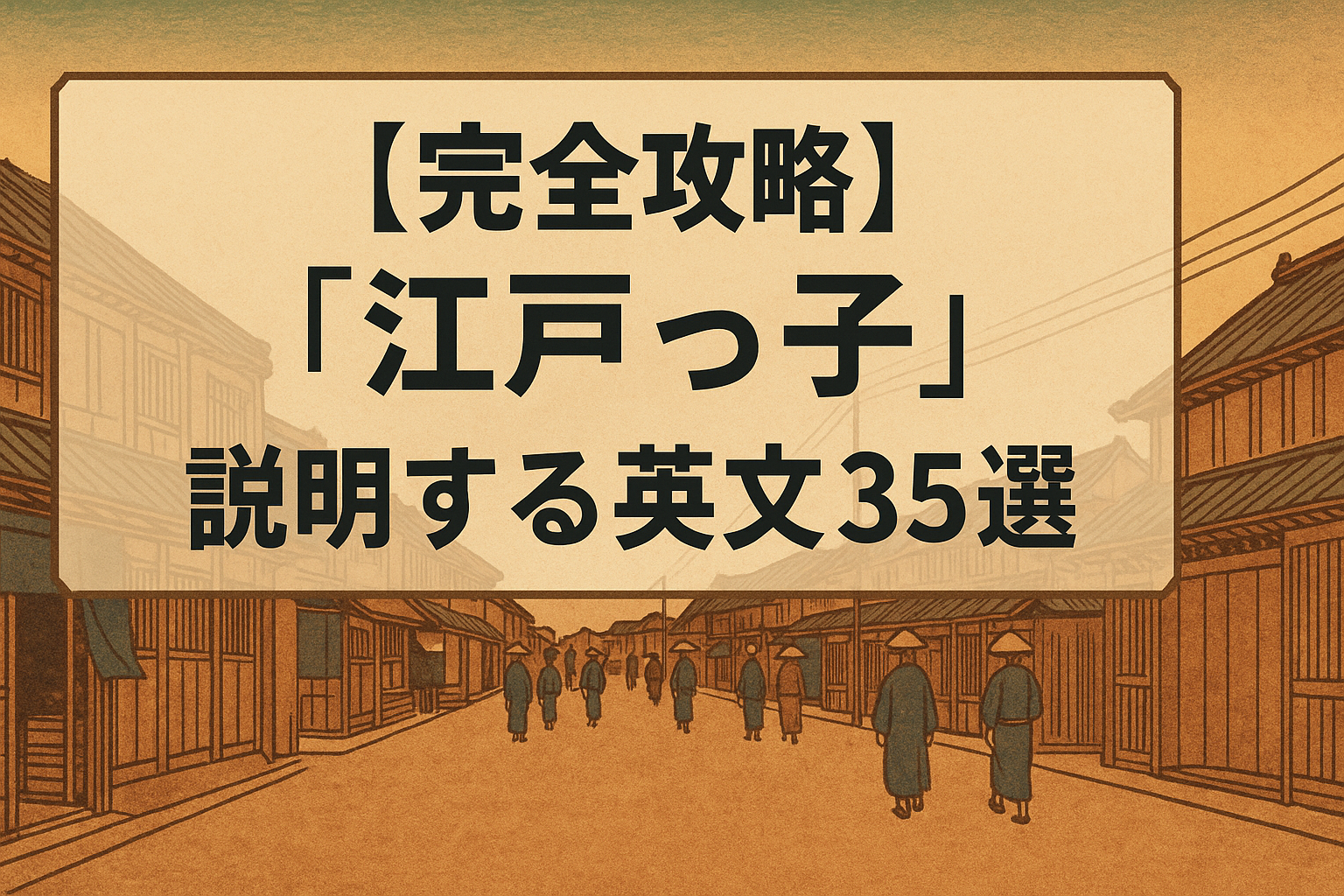今回は「江戸っ子」を説明する英文35選を、特徴別・文化別に整理してお届けします。
外国人の友人や同僚から「江戸っ子って何?」「東京の人と何が違うの?」「どんな特徴があるの?」と聞かれた時、うまく説明できなくて困ったことってありませんか?
そもそも、日本語でもうまく説明できない方も多いかもしれません。
「江戸っ子」に関する知識を補充しつつ、英語表現も確認していきましょう!
基本的な江戸っ子用語
| 日本語 | 英語 |
|---|---|
| 江戸っ子 | Edokko / True Tokyoite |
| 江戸前気質 | Edo spirit / Edo temperament |
| 粋 | Iki / Sophisticated elegance |
| いなせ | Inase / Dapper and spirited |
| 宵越しの金は持たない | Never keep money overnight |
| べらんめえ調 | Beranmee dialect |
| 職人気質 | Artisan spirit |
| 下町文化 | Downtown culture |
📊 江戸っ子説明英文35選
🎭 江戸っ子の基本概念(10文)
1. 定義と歴史的背景
- “Edokko refers to people born and raised in Edo (old Tokyo) for at least three generations.” (江戸っ子とは少なくとも3世代にわたって江戸(旧東京)で生まれ育った人々を指します。)
- “The term literally means ‘child of Edo’ and represents a distinct cultural identity.” (この用語は文字通り「江戸の子」を意味し、独特の文化的アイデンティティを表します。)
- “True Edokko culture developed during the Edo period (1603-1868) among commoners.” (真の江戸っ子文化は江戸時代(1603-1868年)に庶民の間で発達しました。)
- “Edokko identity is not just about birthplace but about inheriting specific values and attitudes.” (江戸っ子のアイデンティティは出生地だけでなく、特定の価値観と態度を受け継ぐことです。)
- “The concept represents the original Tokyo spirit before modernization.” (この概念は近代化以前の東京の原初精神を表しています。)
2. 気質と性格の特徴
- “Edokko are known for their quick temper but equally quick forgiveness.” (江戸っ子は短気だが同じくらい早く許すことで知られています。)
- “They value directness and honesty in communication over diplomatic politeness.” (彼らは外交的な礼儀よりもコミュニケーションにおける率直さと正直さを重視します。)
- “The Edokko spirit embodies a ‘live for today’ philosophy.” (江戸っ子精神は「今日を生きる」哲学を体現しています。)
- “Pride in craftsmanship and attention to detail are hallmarks of Edokko culture.” (職人技への誇りと細部への注意が江戸っ子文化の特徴です。)
- “Edokko traditionally show loyalty to their neighborhood and community.” (江戸っ子は伝統的に自分の近所とコミュニティに忠誠を示します。)
💰 経済観念と生活哲学(8文)
3. 「宵越しの金は持たない」精神
- “The famous saying ‘never keep money overnight’ reflects Edokko spending philosophy.” (「宵越しの金は持たない」という有名な言葉は江戸っ子の支出哲学を反映しています。)
- “Edokko believe in spending money immediately rather than saving for the future.” (江戸っ子は将来のために貯蓄するよりもすぐにお金を使うことを信じています。)
- “This attitude stems from the frequent fires in Edo that could destroy possessions instantly.” (この態度は所有物を瞬時に破壊する可能性がある江戸の頻繁な火事に由来します。)
- “The philosophy emphasizes enjoying life in the present moment.” (この哲学は現在の瞬間に人生を楽しむことを強調します。)
- “Edokko prefer experiences and good food over material accumulation.” (江戸っ子は物質的蓄積よりも経験と美味しい食べ物を好みます。)
4. 価値観と優先順位
- “Quality over quantity is a fundamental Edokko principle in all aspects of life.” (量より質がすべての生活面における江戸っ子の基本原則です。)
- “They value human relationships and social bonds above material wealth.” (彼らは物質的富よりも人間関係と社会的絆を重視します。)
- “Edokko culture emphasizes enjoying seasonal pleasures and festivals.” (江戸っ子文化は季節の楽しみと祭りを楽しむことを強調します。)
🗣️ 言葉遣いとコミュニケーション(7文)
5. べらんめえ調と江戸弁
- “Edokko speak in a distinctive dialect called ‘beranmee-cho’ with rough but friendly tones.” (江戸っ子は荒っぽいが親しみやすい調子の「べらんめえ調」と呼ばれる独特の方言を話します。)
- “The Edo dialect features direct expressions and colorful local phrases.” (江戸方言は直接的な表現と色彩豊かな地元の言い回しが特徴です。)
- “Edokko communication style values brevity and getting straight to the point.” (江戸っ子のコミュニケーションスタイルは簡潔さと要点に直行することを重視します。)
- “They use humor and wit to defuse tension and build rapport.” (彼らはユーモアと機知を使って緊張をほぐし、親密さを築きます。)
- “The speaking style reflects their honest, unpretentious character.” (話し方は彼らの正直で気取らない性格を反映しています。)
6. 社会的交流の特徴
- “Edokko are quick to help neighbors and strangers in need.” (江戸っ子は困っている近所の人や見知らぬ人をすばやく助けます。)
- “They maintain strong community ties through local festivals and events.” (彼らは地元の祭りやイベントを通じて強いコミュニティの絆を維持します。)
🎨 文化的表現と美意識(10文)
7. 「粋」の概念
- “The concept of ‘iki’ represents sophisticated elegance with restraint and subtlety.” (「粋」の概念は抑制と微妙さを伴う洗練された優雅さを表します。)
- “Iki involves understanding beauty in simplicity and avoiding ostentation.” (粋は簡素さの美を理解し、華美を避けることを含みます。)
- “True iki requires deep cultural knowledge and refined aesthetic sense.” (真の粋は深い文化的知識と洗練された美的感覚を必要とします。)
- “Edokko fashion historically favored subtle colors and quality materials over flashy displays.” (江戸っ子のファッションは歴史的に派手な表示よりも微妙な色と高品質な素材を好みました。)
- “The iki aesthetic influences everything from clothing to interior design.” (粋の美学は衣服から室内装飾まですべてに影響します。)
8. 職人文化と技術への敬意
- “Edokko deeply respect skilled craftsmen and traditional techniques.” (江戸っ子は熟練した職人と伝統技術を深く尊敬します。)
- “The pursuit of perfection in one’s craft is considered a noble calling.” (自分の技術における完璧の追求は高貴な天職と考えられています。)
- “Master-apprentice relationships were fundamental to preserving Edokko traditions.” (師弟関係は江戸っ子の伝統を保存するために基本的でした。)
- “Quality workmanship is valued more than speed or profit.” (品質の高い職人技は速度や利益よりも価値があるとされます。)
- “Traditional Edokko culture produced many of Japan’s finest artisans and artists.” (伝統的な江戸っ子文化は日本の最高の職人と芸術家の多くを生み出しました。)
おまけ:他国との比較
イギリスとの比較
- ロンドンっ子: “Like London’s Cockney culture, Edokko represents working-class urban identity with distinctive dialect and values” (ロンドンのコックニー文化のように、江戸っ子は独特の方言と価値を持つ労働者階級の都市アイデンティティを表します)
アメリカとの比較
- ニューヨーカー: “While New Yorkers are known for being direct and fast-paced, Edokko combine directness with traditional craftsmanship values and community bonds” (ニューヨーカーが率直で早いペースで知られている一方、江戸っ子は率直さと伝統的職人技の価値とコミュニティの絆を組み合わせます)
おわりに
いかがでしたか? 以上、江戸っ子を説明する英文35選でした。
江戸っ子は東京の文化的ルーツを表現する重要な概念です。ぜひ、適切な英語表現でその独特の魅力を世界に発信してくださいね!
では!




コメント